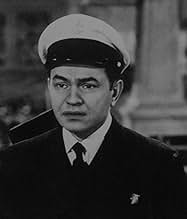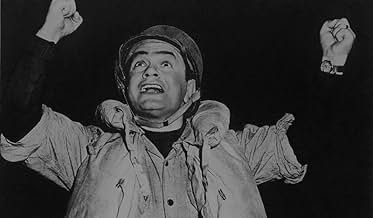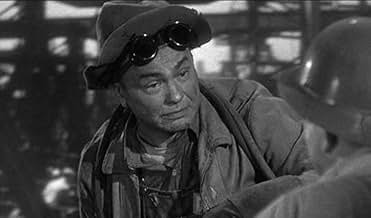AVALIAÇÃO DA IMDb
6,3/10
1,4 mil
SUA AVALIAÇÃO
Adicionar um enredo no seu idiomaA new World War 2 destroyer fails its sea trials so it is assigned to mail runs, but the crew ends up having to engage Japanese planes and a submarine anyway.A new World War 2 destroyer fails its sea trials so it is assigned to mail runs, but the crew ends up having to engage Japanese planes and a submarine anyway.A new World War 2 destroyer fails its sea trials so it is assigned to mail runs, but the crew ends up having to engage Japanese planes and a submarine anyway.
- Direção
- Roteiristas
- Artistas
Edward G. Robinson
- Steve Boleslavski
- (as Edward G.Robinson)
Edward Brophy
- Casey
- (as Ed Brophy)
Frank Beckford
- Yeoman
- (não creditado)
Dean Benton
- Moore
- (não creditado)
Lynton Brent
- Doctor
- (não creditado)
Lloyd Bridges
- 2nd Fireman
- (não creditado)
Charles D. Brown
- Doctor
- (não creditado)
Stanley Brown
- Marine
- (não creditado)
- …
George Bruggeman
- Cook
- (não creditado)
Alma Carroll
- Sailor's Girl Friend
- (não creditado)
Avaliações em destaque
Enjoyable WWII film about an aging sailor (Edward G. Robinson) coming into conflict with a young rival (Glenn Ford). It's all pretty by-the-numbers but some first-rate casting elevates it. Robinson excelled in playing parts like this. He brings a dignity and human touch to it that a lot of other actors wouldn't. Ford is great as well. This is young Glenn Ford before he developed his signature style where he always looked like he was ready to blow his top. There's good support from the likes of Edgar Buchanan, Regis Toomey, the very pretty Marguerite Chapman, and the always likable & funny Leo Gorcey. I'm sure people who are fans of these types of movies will enjoy it.
Steve "Boley" Boleslavski (Edward G. Robinson) and Kansas Jackson (Edgar Buchanan) are old sea dogs who put together the second incarnation of a Navy destroyer called the John Paul Jones. Boley swears it's a great ship, but during its trials, it fails on many counts and is consigned to mail delivery. Morale is low, people want to leave, and on top of all that, Boley has trouble with a crewman named Mickey Donahue (Glenn Ford), who starts seeing Boley's daughter Mary (Marguerite Chapman). How will all these problems be resolved?
This was a fun one. I went in not knowing anything about it, just wanting to see more of Ford and Robinson. Though there are serious moments, mostly of the action variety, this is largely a light comedy, which is not surprising considering people like Buchanan, Leo Gorcey and Ed Brophy are in it. They provide levity, but also some heart.
Far from the best war picture I've seen, but still a good experience. Plus, it's always interesting to see these movies that were made in the middle of the war. Always adds another angle to things.
P.S. Good ol' Regis Toomey has a nice role in this as Boley's superior officer (once trained by Boley), and shockingly, he doesn't play a cop! Well, unless you consider a Lt. Cmdr. in the Navy a cop.
This was a fun one. I went in not knowing anything about it, just wanting to see more of Ford and Robinson. Though there are serious moments, mostly of the action variety, this is largely a light comedy, which is not surprising considering people like Buchanan, Leo Gorcey and Ed Brophy are in it. They provide levity, but also some heart.
Far from the best war picture I've seen, but still a good experience. Plus, it's always interesting to see these movies that were made in the middle of the war. Always adds another angle to things.
P.S. Good ol' Regis Toomey has a nice role in this as Boley's superior officer (once trained by Boley), and shockingly, he doesn't play a cop! Well, unless you consider a Lt. Cmdr. in the Navy a cop.
Others have commented about the fine cast, good acting and relative action in this film. What many viewers – and most or all of the commenters so far – may have missed is that the story and script for "Destroyer" came from Frank "Spig" Wead. Wead had an illustrious Navy career in WWI and later. He was one of the very first Navy fliers and helped promote naval aviation. In 1926, he broke his neck when he fell down the stairs in his family's new home. His surgery was successful, but he had to walk with crutches or a cane the rest of his life. He retired from the Navy and began writing books and screenplays. The latter were mostly about the Navy and most were made into very good movies.
When World War II broke out Wead was reactivated and helped with the planning and tactics involving naval aircraft in the Pacific. He went to sea and took part in several naval battles before finally retiring in early 1944. During the war and for several years after, he wrote the screenplays for a number of movies that Hollywood produced. Other big movies based on his books and screenplays include "Wings for Men" in 1931, "Test Pilot" in 1938, "The Citadel" in 1938, "Dive Bomber" in 1941, and "They Were Expendable" in 1945. Wead died at age 52 in 1947 after surgery. MGM produced a movie in 1957 about him, "The Wings of Eagles." John Wayne and Maureen O'Hara played Spig and his wife, Min.
Something about this movie, with the fact the Spig Wead wrote the story and screenplay, leads me to believe that there is a subtle message in it. The film came out toward the middle of the war, with two more years to go (although no one could know that at the time). And look at the plot. A new ship is taken out for trial runs and has so many things go wrong that it had to come back for repairs at least three times. We see rivets popping, seams leaking, pipes breaking, motors and other things blowing. As a viewer, I thought that the critics in the movie were right. The ship was a piece of junk – in spite of Edward G. Robinson's pleas to the contrary. And, just think – if that happened with all or many ships, it's a wonder we had a Navy afloat at all to do battle.
But that obviously wasn't the case – as the Navy brass ordered the ship to do mail delivery duty because it was unfit for service in the combat fleet. So, this ship just happened to be a lemon, right? Now think back to the opening scenes where Robinson is a civilian working on the crew that is building this new ship. Remember the several instances when he calls different workers to task for cutting corners? He tells one welder that he can't "cold" weld along a seam. The worker says that he can do that, and Robinson says that it would leak and he urges the guy to do it right. We see a few other subtle little scenes like this. I remember thinking that if that's the way the war-time shipbuilding yards were all working, they were sure doing a lot to help the enemy sink our ships.
But the volume of records and evidence we have show that our wartime industries and workers took pride in doing their jobs right and well. They knew that the planes, and ships, and tanks, and weapons they were making were for the Americans and other fighting men who were defending freedom and our shores with their lives. They were their sons and brothers, husbands and fathers, uncles and cousins, and boy friends and neighbors. So, the workers took pride in what they did and in doing it right.
That's why I think Wead wrote a subtle message into the screenplay – and Columbia kept it in the movie intentionally. It was a message to the home front workers about how important their jobs were and that they needed to do them well. The movie gave a picture of what could happen if the home front workers did sloppy work or cut corners. They would endanger the lives of many fellow Americans. They could cause the loss of ships, aircraft and battles.
If you doubt this, watch the movie again, and watch for those instances of shoddy or faulty workmanship that Robinson points out to his fellow workers. And then watch for the problems they have during their trial runs to get the ship battle ready. I'll just bet that the home front workers who saw this movie in 1943 were more than a little upset at what they saw. And if it had been up to them in real life, all those goldbrickers in the movie shipyard would have been canned.
When World War II broke out Wead was reactivated and helped with the planning and tactics involving naval aircraft in the Pacific. He went to sea and took part in several naval battles before finally retiring in early 1944. During the war and for several years after, he wrote the screenplays for a number of movies that Hollywood produced. Other big movies based on his books and screenplays include "Wings for Men" in 1931, "Test Pilot" in 1938, "The Citadel" in 1938, "Dive Bomber" in 1941, and "They Were Expendable" in 1945. Wead died at age 52 in 1947 after surgery. MGM produced a movie in 1957 about him, "The Wings of Eagles." John Wayne and Maureen O'Hara played Spig and his wife, Min.
Something about this movie, with the fact the Spig Wead wrote the story and screenplay, leads me to believe that there is a subtle message in it. The film came out toward the middle of the war, with two more years to go (although no one could know that at the time). And look at the plot. A new ship is taken out for trial runs and has so many things go wrong that it had to come back for repairs at least three times. We see rivets popping, seams leaking, pipes breaking, motors and other things blowing. As a viewer, I thought that the critics in the movie were right. The ship was a piece of junk – in spite of Edward G. Robinson's pleas to the contrary. And, just think – if that happened with all or many ships, it's a wonder we had a Navy afloat at all to do battle.
But that obviously wasn't the case – as the Navy brass ordered the ship to do mail delivery duty because it was unfit for service in the combat fleet. So, this ship just happened to be a lemon, right? Now think back to the opening scenes where Robinson is a civilian working on the crew that is building this new ship. Remember the several instances when he calls different workers to task for cutting corners? He tells one welder that he can't "cold" weld along a seam. The worker says that he can do that, and Robinson says that it would leak and he urges the guy to do it right. We see a few other subtle little scenes like this. I remember thinking that if that's the way the war-time shipbuilding yards were all working, they were sure doing a lot to help the enemy sink our ships.
But the volume of records and evidence we have show that our wartime industries and workers took pride in doing their jobs right and well. They knew that the planes, and ships, and tanks, and weapons they were making were for the Americans and other fighting men who were defending freedom and our shores with their lives. They were their sons and brothers, husbands and fathers, uncles and cousins, and boy friends and neighbors. So, the workers took pride in what they did and in doing it right.
That's why I think Wead wrote a subtle message into the screenplay – and Columbia kept it in the movie intentionally. It was a message to the home front workers about how important their jobs were and that they needed to do them well. The movie gave a picture of what could happen if the home front workers did sloppy work or cut corners. They would endanger the lives of many fellow Americans. They could cause the loss of ships, aircraft and battles.
If you doubt this, watch the movie again, and watch for those instances of shoddy or faulty workmanship that Robinson points out to his fellow workers. And then watch for the problems they have during their trial runs to get the ship battle ready. I'll just bet that the home front workers who saw this movie in 1943 were more than a little upset at what they saw. And if it had been up to them in real life, all those goldbrickers in the movie shipyard would have been canned.
Edward G. Robinson is a retired Navy officer who works on building a new ship. He succeeds in gaining a berth when it is ready to sail but he finds he is a bit out of touch with the young crew. He experiences a few highs and lows and faces several challenges throughout. Very good performance with a few memorable scenes. I rated it a 7.
First Rate for the period. A good patriotic Navy film, in the class with "Men of Honor" and Top Gun. Great depiction of sailors,Ships and the sea. As a U.S. Navy Veteran and "Tin-can-Sailor" an affectionate term for "Destroyer" Sailors, this shows the connection of the men and the Ship. The personality and the Valor of the Ship and her namesake and the men that make HER sail. To the sailor she is more than just steel that floats, she is Life; one lives, eats and sleeps the ship. If she don't float, we die. She takes us in harm's way and if we do it right, she brings us home. Home is the sailor, home from the sea. "Well done "Boli."
Você sabia?
- CuriosidadesThe USS John Paul Jones in reality was the Benson Class destoyer USS Hobby (DD610). She was primarily used for Anti-Submarine Warfare (ASW) in both the Mediterranean and Pacific theaters. She servived the war, but would eventually be destroyed as a training target in 1972.
- Erros de gravaçãoWhen the Japanese torpedo strikes the John Paul Jones II, the ship's interior is shown to have its interior watertight doors open. Part of General Quarters (Battle Stations) procedure is to establish watertight integrity throughout a ship by shutting all watertight doors. This minimizes flooding in the event the ship is struck by enemy fire.
- Citações
Girl at USO: I hear you got a raise.
Kansus Jackson: Yeah
Girl at USO: What are you going to spend it on?
Kansus Jackson: Oh, beer, women and the rest on foolishness.
- Cenas durante ou pós-créditosOpening credits prologue:
Destroyers --"Tin Cans" as they are affectionately called by those who man them -- are the busybodies of the Fleet.
Always looking for trouble -- generally finding it.
Proud little ships because they bear the names of great heroes of the Service and keep alive the fighting traditions of our Navy.
Principais escolhas
Faça login para avaliar e ver a lista de recomendações personalizadas
- How long is Destroyer?Fornecido pela Alexa
Detalhes
- Data de lançamento
- País de origem
- Idiomas
- Também conhecido como
- Algo más que la vida
- Locações de filme
- Empresa de produção
- Consulte mais créditos da empresa na IMDbPro
- Tempo de duração1 hora 39 minutos
- Cor
- Proporção
- 1.37 : 1
Contribua para esta página
Sugerir uma alteração ou adicionar conteúdo ausente




































